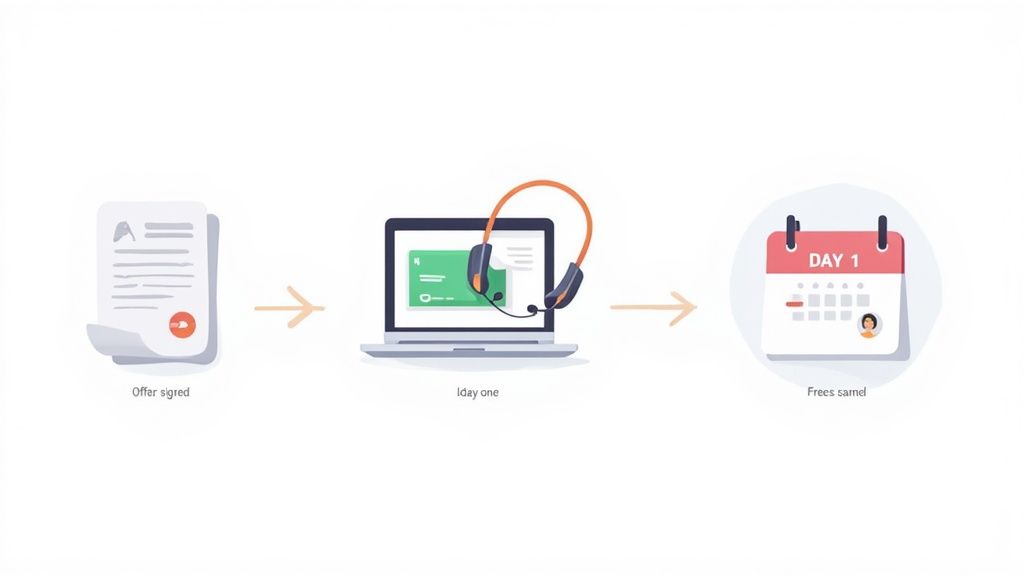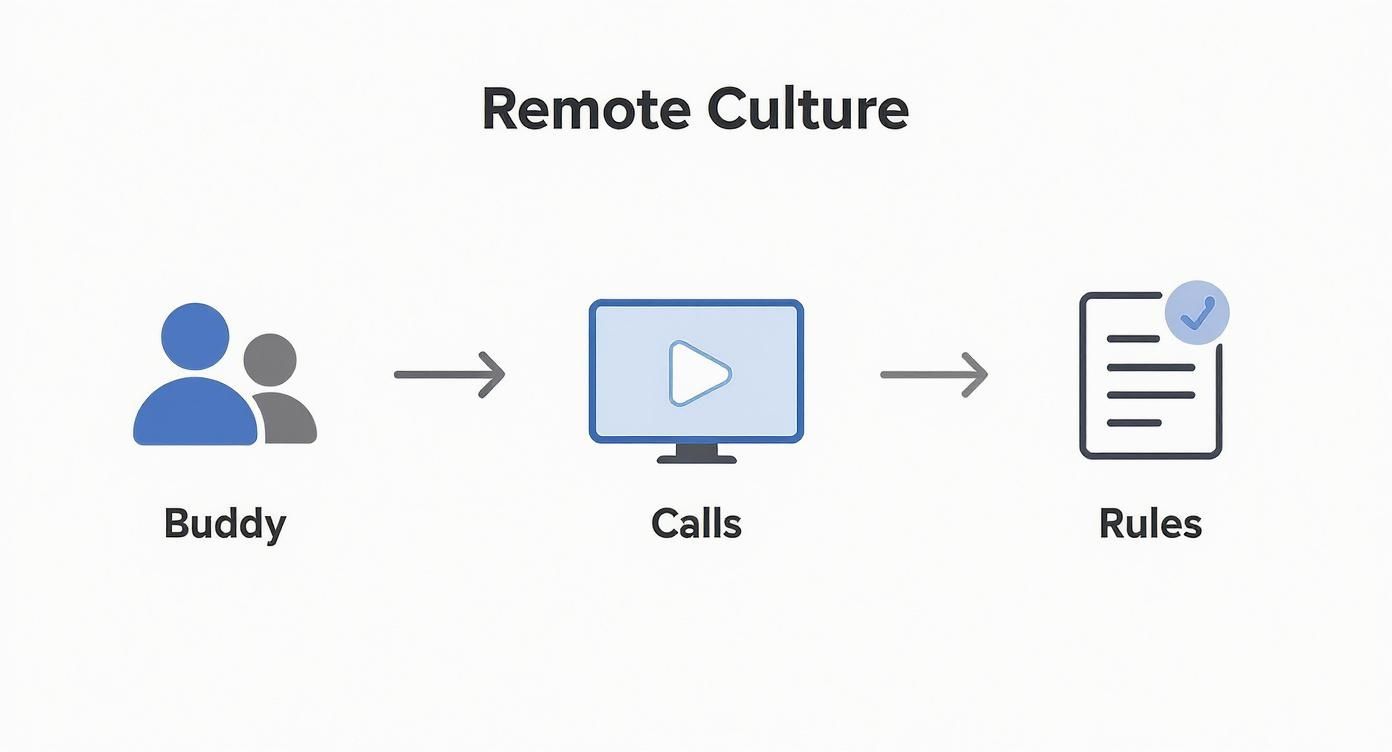
 17 minutes read
17 minutes read
Let's be real: that welcome email and PDF handbook you send out aren't cutting it. Proper remote onboarding isn't an administrative checklist; it’s a deliberate, human-focused process that proves you have your act together. It needs a real plan that kicks off before day one, pulls new hires into your firm's culture, and gives them consistent support through their first 90 days.
If you think you can just wing it, you're already behind.
For most new remote hires, their first week feels like being dropped into a foreign country with a bad map and no translator. We’ve all been on the receiving end of it—the awkward silences on Zoom, the day-one tech fiascos, and the cultural void that makes you feel like a ghost in the machine. It’s a terrible first impression.

This isn't just a feeling, either. The data is brutal. A staggering 42% of fully remote new hires called their onboarding experience 'truly terrible.' The main culprits? Poor communication of company culture and inadequate tech support. You can dive deeper into these onboarding statistics if you enjoy a good horror story.
A bad start almost guarantees a quick exit. Get this part wrong, and you’re just renting talent. But get it right, and you start building loyalty from the very first click.
The problem is that too many firms treat onboarding as a simple HR function—a series of forms to sign and compliance modules to complete. It’s transactional, not relational. But for a remote employee, this initial period is their only window into your firm’s personality, its unwritten rules, and whether they’ve actually made the right decision.

The biggest mistake I see is firms assuming their in-office process translates directly to a remote environment. It doesn’t. You can’t replicate spontaneous coffee-machine conversations or a junior associate overhearing a senior partner’s client call. You have to intentionally create those connection points.
So, what are the classic red flags that your process is broken?
This isn't about ticking boxes on a Trello board. It's about preventing that sinking feeling of isolation that pushes talented people to start polishing their resumes within the first month. This guide is built from years in the trenches to help you fix that.
Let's get one thing straight: onboarding doesn't start on day one. It starts the second that offer letter is signed. That in-between period—pre-boarding—is your golden opportunity to prove you have your act together. Nail this part, and your new hire shows up excited and ready to contribute. Fumble it, and they arrive riddled with anxiety, already second-guessing their decision.
This isn't just about getting paperwork out of the way. It's about professional foresight. The goal is to eliminate that classic day-one chaos so their first hours are spent connecting with colleagues, not wrestling with a faulty VPN.

Hope you enjoy spending your afternoons playing impromptu IT help desk—because shipping the laptop a day before they start is a recipe for disaster. Courier delays happen. Laptops arrive damaged. Home internet providers mysteriously go on the fritz.
Your pre-boarding tech checklist should be non-negotiable.
This isn't just about logistics; it’s a powerful signal that you respect their time. An attorney or paralegal forced to spend their first day as an unpaid IT technician is not going to be a happy camper. For a deeper look at the infrastructure needed, our guide to succeeding with virtual paralegal employment is a great resource.
Nothing screams "we're disorganized" louder than a new hire logging in to a completely empty calendar. They're left wondering if anyone even remembered they were starting today. You absolutely must send a clear, concise First Week Itinerary at least three days before their start date.

This isn't hand-holding; it’s setting clear expectations. A structured first week transforms a new hire’s anxiety into focused energy. It tells them exactly where to be, who they’re meeting, and what they need to accomplish.
Your itinerary should be a thoughtful mix of structured meetings and protected time. Here’s what a solid Day One schedule often looks like:
This simple document removes all the guesswork. It makes your new hire feel like they’re joining a well-oiled machine, not a circus. And when it comes to onboarding, that first impression is everything.
Let’s talk about the welcome box, because most companies get this spectacularly wrong. They ship a flimsy cardboard box with a cheap, branded mug that cracks in the dishwasher, a pen that dies mid-sentence, and a notebook that gathers dust. Congratulations, you’ve just told your new hire they’re worth about $15 of factory-made junk.
We can do better.
A high-impact welcome experience isn't about mortgaging your office ping-pong table to send everyone a new Peloton. It’s about being thoughtful. This is your first tangible, physical handshake, and it needs to say, “We’re genuinely glad you’re here, and we’ve thought about what you actually need to do great work.” Honestly, it's your best shot at making someone feel valued before they’ve even logged in.

So, what goes into a welcome kit that doesn't immediately end up in a donation pile? Forget the swag-as-an-afterthought approach. Instead, think about the real-world headaches your remote team faces every single day.

The goal isn't to spend a fortune; it's to be intentional. A thoughtfully curated kit, timed to arrive a few days before their start date, builds genuine excitement and reinforces their decision. It’s basic psychology, and it works.
The welcome experience has to extend beyond the physical box. Tucked inside their kit, include a nicely printed copy of their first-week itinerary and a welcome letter from their direct manager or the managing partner.
This letter should also point them toward key foundational documents. One of the best things you can do is give them a clear map of how your firm operates from day one. You can learn more about structuring these critical guides in our post on how to create standard operating procedures. Linking the tangible welcome to the digital workspace creates a cohesive, impressive experience right from the start.
Ultimately, this first touchpoint sets the tone for everything that follows. It's the difference between a new hire feeling like a valued professional and feeling like another cog in a faceless machine. Make it count.
Let’s be honest. Culture isn’t a ping-pong table or free snacks. If you’re still clinging to that idea, you’ve already lost the remote work game. Culture is about shared behaviors, psychological safety, and the unwritten rules of how work actually gets done. Building it when your team is scattered across the country is the final boss of remote employee onboarding.
You can't just hope a new hire absorbs your culture through osmosis. They won’t overhear a senior paralegal’s masterclass in client de-escalation or pick up on team inside jokes during a lunch break. You have to be deliberate.
And the stakes couldn't be higher. A recent study revealed that a staggering 63% of remote workers feel undertrained by their onboarding, and 60% report feeling disoriented after the experience. Discover more on how these early missteps impact engagement by reading the full findings on onboarding stats.
Most "buddy systems" are a joke. You pair a new hire with a random tenured employee, tell them to "connect," and then never follow up. The result? One awkward 15-minute Zoom call where they both stare at the screen and talk about the weather. It’s a box-ticking exercise, not a culture-building one.
Let’s try Buddy System 2.0.
This isn’t about making friends, although that can happen. It’s about creating a safe, informal channel for the new hire to ask the "stupid" questions they'd be too intimidated to ask their manager. Questions like, "Does everyone really sign off at 5 PM, or is that just a suggestion?"
Every firm has them. The unspoken expectations about response times on Slack, how to escalate a problem, or the proper way to disagree during a team meeting. Leaving a new remote hire to guess these rules is a recipe for anxiety and missteps.

Your best remote employees aren't just great at their jobs; they’re experts at navigating your company culture. Documenting your unwritten rules is how you clone their success and hand that playbook to every new hire.
So, create a simple, one-page document called "How We Work."
This isn't your formal employee handbook. It’s a candid guide to your firm’s quirks and communication norms. Include things like your philosophy on meeting length, preferred channels for different types of questions (Slack vs. email vs. call), and examples of what good asynchronous communication looks like.
Sharing this early on is a critical step for boosting new hire efficiency. To take this further, check out our guide on remote work productivity tips that can help the whole team. This simple act of transparency transforms the mysterious art of "fitting in" into a clear, learnable skill.
Alright, let's kill the idea that onboarding is a one-week, box-ticking exercise. If you think a new hire is fully integrated after five days, you're setting them up to fail. The real work—transforming a nervous newbie into a confident, productive team player—happens over the first three months.
This is the marathon, not the sprint. It’s where you prove that all the pre-boarding magic wasn't just for show. You need a structured 30-60-90 day plan that actually gets results.
Forget vague goals like "learn the ropes" or "get up to speed." That’s lazy management. We need clear, measurable milestones that tell a new hire exactly what success looks like at each stage. This isn't just about their productivity; it's about their confidence.
A great 30-60-90 plan is built on three core pillars:
This framework gives your new hire a roadmap. It removes the guesswork and helps them focus their energy where it matters most, building momentum from day one. A structured plan also helps you, as a manager, spot roadblocks early. Instead of a generic "how's it going?" check-in, your conversations become targeted and productive.
This infographic lays out how to embed your culture remotely by focusing on the buddy system, structured video calls, and clear documentation.

This process visualizes the crucial human elements that prevent a new hire from feeling like they're just an icon on a screen. To make this practical, here’s a simple table you can adapt for your firm’s needs. It provides a clear structure for setting expectations and tracking progress during that critical initial period.
| Timeframe | Main Focus | Key Goals | Manager Check-in Focus |
|---|---|---|---|
| Days 1-30 | Learning & Acclimation | – Complete all required HR and compliance training. – Master core software (case management, billing). – Build rapport with the immediate team and assigned buddy. |
Are they getting the support they need? Are there any tech or access roadblocks? |
| Days 31-60 | Contribution & Integration | – Take ownership of a few small, low-risk tasks. – Begin contributing in team meetings. – Shadow a key process from start to finish. |
Where are they gaining confidence? What skills need more development? |
| Days 61-90 | Independence & Initiative | – Manage assigned tasks with minimal supervision. – Identify one process improvement suggestion. – Proactively seek feedback on their work. |
How are they integrating with the broader firm culture? What are their long-term goals? |
This framework isn't set in stone. Tailor it for each role, but having a consistent structure ensures no one falls through the cracks. It's about creating a predictable path to success.
Your weekly check-ins during this 90-day window need to be more than status updates. They are your primary tool for diagnosing issues before they fester. Ditch the surface-level questions and dig deeper.
Here are some questions that get real answers:
These questions force reflection and create openings for honesty. They tell you where your processes are breaking down and where your team is shining.

Your onboarding process should never be static. Every new hire is a data point. The feedback you collect from them—especially in the first 90 days—is the most valuable information you'll get for improving your system.
The shift to remote work has made this structured approach more critical than ever. In fact, 54% of companies now opt for virtual onboarding, and the results are impressive. Remote onboarding satisfaction has reached 87%, even surpassing traditional in-office programs. You can explore more findings in these employee onboarding statistics.
Ultimately, a well-executed 90-day plan is your final, most important step. It's how you ensure that the person you were so excited to hire becomes an indispensable part of your firm's future. Don't leave it to chance.
We’ve walked through the a-to-z of setting up a remote onboarding process. But I know from experience that the real head-scratchers come up when you’re actually doing it. Here are a few of the most common—and critical—questions I hear from firm managers trying to get this right.
Success isn't just about checking boxes. It’s measured by a few very real, very telling metrics.
First, look at time-to-productivity. How long does it take for your new paralegal to start handling tasks effectively without constant hand-holding? If they're still struggling after 60 days, your process has a gap.
Next is your 90-day retention rate. This one is brutally honest. Are your new hires staying? If you see a pattern of people leaving within the first few months, your onboarding is likely the culprit. You're not just losing a person; you're losing all the time and money you invested in finding them.
Finally, you need direct feedback. Anonymous new hire engagement surveys are your best friend. Ask pointed questions like, "Do you feel you have the tools you need to succeed?" or "On a scale of 1-10, how connected do you feel to your team?" The answers will be a goldmine.
Easy. Treating onboarding like a purely administrative task instead of a profoundly human experience.
The process isn't just about setting up payroll and getting I-9 forms signed. The biggest blunder I see is a firm emailing a new hire a link to a portal full of documents and just expecting them to figure out the culture and unwritten rules.

Onboarding is an ongoing conversation, not a one-time data dump. If your process feels as impersonal as a trip to the DMV, you’ve failed before they’ve even logged in.
It has to be about connection, building relationships, and clarifying expectations. You simply can't automate a sense of belonging.
There isn’t a one-size-fits-all answer, but think about the impact you want to make, not just the cost. A great starting point is somewhere between $250 and $500 per new hire.
If that number gives you sticker shock, consider the alternative. A cheap welcome kit sends a clear message: "You're a line item, not a valued team member."
That budget allows you to provide genuinely useful, high-quality gear (like a noise-canceling headset that actually works) alongside thoughtful, personal touches (like a gift card to a great local coffee shop). The return on investment isn't the swag itself; it's the powerful first impression that you are genuinely invested in their success. That initial loyalty is worth every penny.
Stop wasting time on disorganized hiring processes. HireParalegals connects you with over 10,000 pre-vetted legal professionals, ready to start in as little as 24 hours. Find your next remote team member today.